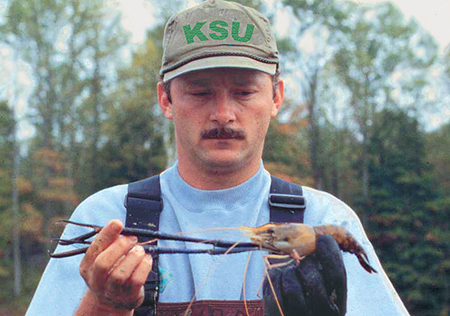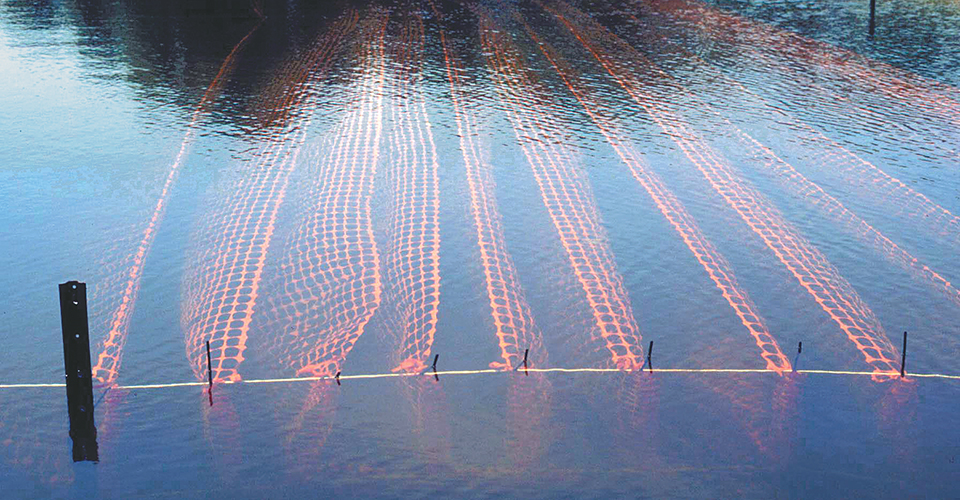Low production costs noted for ‘phased-feeding’ treatment

Commercial culture of the freshwater prawn (Macrobrachium rosenbergii) in the United States has increased in recent years, with an estimated 600 ha of pond area now under production. Production has been low compared to species like catfish and penaeid shrimp, but recent developments that include added substrate, increased stocking densities and feed rates, and size grading have significantly raised production rates.
At biomass densities below 1,000 kilograms per hectare, prawns benefit substantially from natural productivity in ponds. At higher densities, prawns – especially the larger, high-value animals – are likely to be dependent on commercial feeds.
Nutritional requirements
Prawns have typically been fed agroindustrial byproducts or low-protein diets, primarily to enhance natural pond productivity rather than as a complete diet. However, research has shown that, physiologically, freshwater prawns have nutritional requirements similar to penaeid shrimp, which are typically fed high-protein, high-quality diets. To assure that maximum potential production is achieved, adequate diets must be available.
Relative feed costs
In prawn farming, feed costs reflect a relatively small proportion of total costs (5 to 15 percent), when compared to many other species. For channel catfish and rainbow trout, for example, feed typically represents 45 and 50 percent, respectively, of production expenses.
Phase feeding
Recent studies at Kentucky State University in Frankfort, Kentucky, USA used “phase feeding,” where diets with increasing protein levels were applied through the production cycle. While protein requirements usually decrease as animals grow, this approach assumes that as prawn biomass increases, the supply of natural food is grazed down and contributes less high-quality nutrition over time.
Increasing protein
During the studies, prawns were fed a 22 percent protein organic fertilizer at 20 kilograms per hectare per day for the first month, followed by a 28 percent protein steam-pelleted diet for the next six weeks. Prawns then received a 40 percent protein marine shrimp diet for the remaining four weeks of the production season.
Increased production, increased cost
Feed rates were increased approximately 20 percent above previously used feed table guidelines to ensure that feed amount was not a limiting factor. When the technologies of added substrate and increased stocking density were changed, production rates increased from 900-1,000 kilograms per hectare to over 2,500 kilograms per hectare in the research ponds.
While the changes in feeds and feeding were effective, they were also expensive, so a series of studies was initiated to evaluate the cost per benefit relationships of different feeding scenarios.
Nutrient-dense diet
In 2000, Kentucky State University compared the effect of feeding a nutrient-dense, 40 percent-protein penaeid diet throughout the production period to phase feeding. After 106 days, prawns fed the penaeid diet exclusively showed no production advantage over prawns under the phase-feeding treatment. However, production costs for the latter were substantially lower due to the high cost of the penaeid diet.
There was no apparent benefit to using the more expensive, higher-protein diets during the first 12 weeks of prawn production. Although increased competition for natural food at higher densities eventually becomes a limiting factor, it appears that supplemental feeds are sufficient for at least the first 80 days.
Steam-pelleted diet
In 2001, the university compared phase feeding with feeding a 32 percent protein, steam-pelleted diet similar to catfish feed exclusively throughout production. At harvest, there was no difference in average prawn weight or total production (28 grams and 2,300 kilograms per hectare, respectively) between the treatments.
However, the percentage of animals that grew over 30 grams increased by about 20 percent in the phase-fed treatment. The added expense of the marine shrimp diet at the end of phase feeding resulted in an approximate U.S. $1.00 per kilogram increase in the break-even price compared to feeding the 32 percent diet throughout. If the market will pay more for large animals, the added expense may be justified.

Feeding rates and stocking densities
In these research trials, feed rates were increased 20 percent over recommended table values, and stocking densities were relatively high – 65,000 animals per hectare in the 2000 study, and 79,000 animals per hectare in 2001. These factors can intensify management requirements, such as aeration, water quality monitoring and periodic flushing, as daily feed rates often exceeded 88 kilograms per hectare in research ponds.
If lower feed rates are used, it may be important to provide a higher-quality diet as natural productivity is diminished (such as in phase feeding). At stocking densities below 39,500 per hectare, better-quality diets and increased feed rates would likely be less important.
Conclusion
In freshwater prawn production, feed inputs serve as organic fertilizers as much as direct sources of nutrition, especially early in the production cycle. As a result of this feeding preference, more research should be directed toward the development of management practices that maximize the availability of preferred natural food items. Additional research is needed to determine the most economical diets and feeding techniques for efficient pond production of freshwater prawns.
(Editor’s Note: This article was originally published in the April 2002 print edition of the Global Aquaculture Advocate.)
Now that you've finished reading the article ...
… we hope you’ll consider supporting our mission to document the evolution of the global aquaculture industry and share our vast network of contributors’ expansive knowledge every week.
By becoming a Global Seafood Alliance member, you’re ensuring that all of the pre-competitive work we do through member benefits, resources and events can continue. Individual membership costs just $50 a year. GSA individual and corporate members receive complimentary access to a series of GOAL virtual events beginning in April. Join now.
Not a GSA member? Join us.
Authors
-
Shawn Coyle
Kentucky State University
Aquaculture Research Center
103 Athletics Road
Frankfort, Kentucky 40601 USA -
James Tidwell, Ph.D.
Kentucky State University
Aquaculture Research Center
103 Athletics Road
Frankfort, Kentucky 40601 USA
Related Posts

Intelligence
Culture of giant freshwater prawns in China
Farming of giant freshwater prawns is very popular in China. The Yangtze River Delta region produces more than 60 percent of the country's output. Production increases have resulted from a novel system that involves greenhouses that allow ponds to be stocked ahead by two months.

Aquafeeds
Feeding strategy supports freshwater prawns without fishmeal, fish oil
Low-input culture practices for freshwater prawns can manage their growth and biological characteristics so they can be fed no fishmeal or fish oil.

Health & Welfare
Ammonia toxicity degrades animal health, growth
Ammonia nitrogen occurs in aquaculture systems as a waste product of protein metabolism by aquatic animals and degradation of organic matter, or in nitrogen fertilizers. Exposure can reduce growth and increase susceptibility to diseases in aquatic species.

Intelligence
An inside look at Sino Agro Foods’ giant prawn MegaFarm
Sino Agro Foods has developed a proprietary recirculating aquaculture system that yields high production volumes and profitability. The facility should significantly contribute to seafood production in China and to help satisfy increasing demand for high value, safe and sustainably produced seafood.


